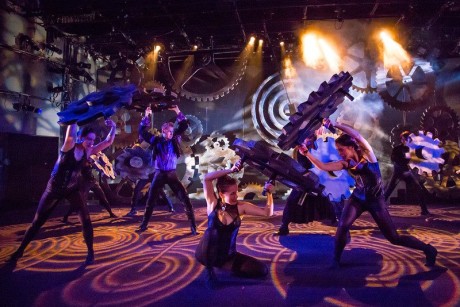Ah, the importance of the costumes actors wear to set the scene for any stage production: the shapes, colors, textures. How the fabric flows, drapes, curves or hugs fast to an actor’s frame. Does the costume shyly obscure or powerfully push a character into the audience’s attention or illustrate distinctive aspects of a character commanding notice one way or another?

Costumes are clearly “wordlessly” potent clues about mood and relationships, particularly as accessories like shoes and jewelry are added, and perhaps even wigs and, of course, make-up.
Let us not forget that costumes serve way more than just for the audience’s enjoyment. They also speak with authority to the actors as they see and interact with one another on stage. In costume actors are no longer friends and a company of workers brought together for a production. They become “the” characters being portrayed in the guise of playful, powerful, innocent, muscular, pure, shy, or maybe even vulgar or creepy
When costumes are worn, they speak to both actors and audience alike as a look-glass into characters: the external embodiment reinforced when the actor takes that one last look in the mirror. As Bruce Springsteen’s lyric from Dancing’ in the Dark, might be a good place for a metaphor: “Message keeps getting clearer. Radio’s on and I’m moving ‘round the place. I check my look in the mirror.”
The trigger for this column came from a recent evening with Synetec’s returning production of its 2009 multi-Helen Hayes awarded Romeo and Juliet. I wanted to learn how the Synetic team of costume designer, Anastasia Sims, costume coordinator, Aralia Toney, and Anastasia Whittle, the production’s wardrobe manager, work together to develop, produce and maintain the costumes for a physical and movement-based production, as the costumes must receive a rough usage over the run of the production.
To start, according to Director and Adaptor Paata Tsikurishvili of Synetic’s Romeo and Juliet and Anastasia Simes,”The movement is so important, that if you supply too much color it distracts from the ensemble composition.”

“Costumes are so important when it comes to Synetic’s rendition of a wordless Romeo and Juliet. Costumes tell the audience the time period, a specific location and lastly they tell you when a scene has changed.” said Whittle. “Costumes bring everything together in telling a story.”
When asked about the durability of the costumes given the physical, movement orientation of Synetic productions, Whittle indicated that “they are major influences about the wearability of the costumes since the actors are constantly moving every second on stage. A lot of stretch materials and breathable fabrics are used. You want to make sure that they can move and perform at their best while also looking great.”
Whittle went on to chat about the shoes that the actors wear. The shoes comfort and wearability are critical in a Synetic production. The actors do not only stand or move gently about the stage. “Since Synetic is a very physical and dance oriented company, shoes are a very important. We often order double since we go through them from the beginning of tech to when the show finally opens.” The footwear does wear out from heavy use or need fixes during a performance. So an extra pair of footwear is available each and every performance just in case.
In Romeo and Juliet, “the men are wearing marching band boots which hold up very well throughout the dance and fight scenes. The women are wearing high top canvas dance shoes that do tend to acquire holes but are easily repairable with some patch work.” added Whittle.
Synetic’s current production of Romeo and Juliet uses some of the same costumes from the previous production of Romeo and Juliet. The costumes were altered to fit the current production’s actors according to Whittle. But, she reminded me that during the run of a production, costumes take punishment. “I am at every performance helping actors with quick changes and any wardrobe emergencies that may happen.”
And the emergency repairs require not only deft quickness, but be accomplished noiselessly in the wings or backstage. The costumes are made to be repairable so the actor and the show can go on with any unexpected predicament. That is the responsibility of the Synetic wardrobe manager
I asked Whittle one last question, which brought a chuckle from her. Well, you see, dear readers, my Dad and grandfather were tailors, dry cleaners and furriers so I came to be aware of fabric care at a very young age. Whittle was very kind in her response to me. “Yes, the costumes are washed every night. Shirts and pants are washed every day and on two shows days they are washed in between shows. Corsets are hand washed every 2 days so they have time to properly dry. “
“Pieces that cannot be put in the washer are sprayed with a spray to eliminate odors and keeps it fresh,” added Whittle who is at every performance helping actors “with quick changes and any wardrobe emergencies that may happen.” Now, that is devotion to a production and what theater artists are all about, whether on the stage before the audience, or the many behind the scenes that make a show what it is.
Running Time: 80 minutes, with no intermission.
Romeo and Juliet plays through March 27, 2016 at Synetic Theatre – 1800 South Bell Street, Arlington, VA. For information or to purchase tickets, call (866) 811-4111, visit their website.





